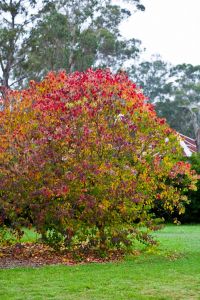
by Sheila Dunning | Oct 20, 2015
 As the trees begin to turn various shades of red, many people begin to inquire about the Popcorn trees. While their autumn coloration is one of the reasons they were introduced to the Florida environment, it took years for us to realize what a menace Popcorn trees become. Sapium sebiferum, the Chinese tallowtree or Popcorn tree, was introduced to Charleston, South Carolina in the late 1700s for oil production and use in making candles. Since then, it has spread to every coastal state from North Carolina to Texas, and inland to Arkansas. In Florida it occurs as far south as Tampa. It is most likely to spread to wildlands adjacent to or downstream from areas landscaped with Sapium sebiferum, displacing other native plant species in those habitats. Therefore, Chinese tallowtree was listed as a noxious weed by the Florida Department of Agriculture and Consumer Services Noxious Weed List (5b-57.007 FAC) in 1998, which means that possession with the intent to sell, transport, or plant is illegal in the state of Florida.
As the trees begin to turn various shades of red, many people begin to inquire about the Popcorn trees. While their autumn coloration is one of the reasons they were introduced to the Florida environment, it took years for us to realize what a menace Popcorn trees become. Sapium sebiferum, the Chinese tallowtree or Popcorn tree, was introduced to Charleston, South Carolina in the late 1700s for oil production and use in making candles. Since then, it has spread to every coastal state from North Carolina to Texas, and inland to Arkansas. In Florida it occurs as far south as Tampa. It is most likely to spread to wildlands adjacent to or downstream from areas landscaped with Sapium sebiferum, displacing other native plant species in those habitats. Therefore, Chinese tallowtree was listed as a noxious weed by the Florida Department of Agriculture and Consumer Services Noxious Weed List (5b-57.007 FAC) in 1998, which means that possession with the intent to sell, transport, or plant is illegal in the state of Florida.
Although Florida is not known for the brilliant fall color enjoyed by other northern and western states, we do have a number of trees that provide some fall color for our North Florida landscapes. Red maple provides brilliant red, orange and sometimes yellow leaves. The native Florida maple, Acer saccharum var. floridum, displays a combination of bright yellow and orange color during fall. And there are many Trident and Japanese maples that provide striking fall color. Another excellent native tree is Blackgum, Nyssa sylvatica. This tree is a little slow in its growth rate but can eventually grow to seventy-five feet in height. It provides the earliest show of red to deep purple fall foliage. Others include Persimmon, Diospyros virginiana, Sumac, Rhus spp. and Sweetgum, Liquidambar styraciflua. In cultivated trees that pose no threat to native ecosystems, Crape myrtle, Lagerstroemia spp. offers varying degrees of orange, red and yellow in its leaves before they fall. There are many cultivars – some that grow several feet to others that reach nearly thirty feet in height. Chinese pistache, Pistacia chinensis, can deliver a brilliant orange display.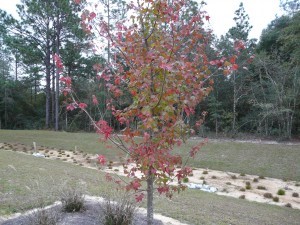
There are a number of dependable oaks for fall color, too. Shumardi, Southern Red and Turkey are a few to consider. These oaks have dark green deeply lobed leaves during summer turning vivid red to orange in fall. Turkey oak holds onto its leaves all winter as they turn to brown and are pushed off by new spring growth. Our native Yellow poplar, Liriodendron tulipifera, and hickories, Carya spp., provide bright yellow fall foliage. And it’s difficult to find a more crisp yellow than fall Ginkgo, Ginkgo biloba, leaves. These trees represent just a few choices for fall color. Including one or several of these trees in your landscape, rather than allowing the Popcorn trees to grow will enhance the season while protecting the ecosystem from invasive plant pests.
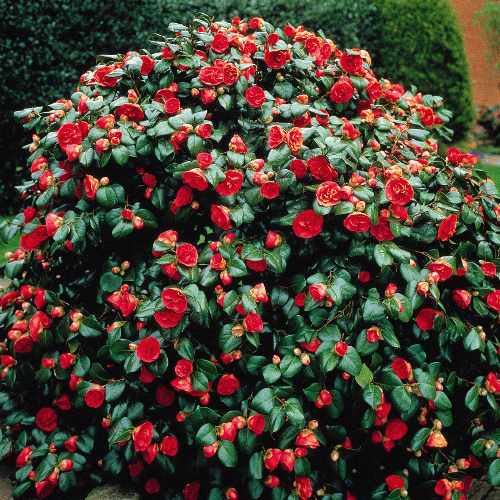
by Julie McConnell | Oct 15, 2015
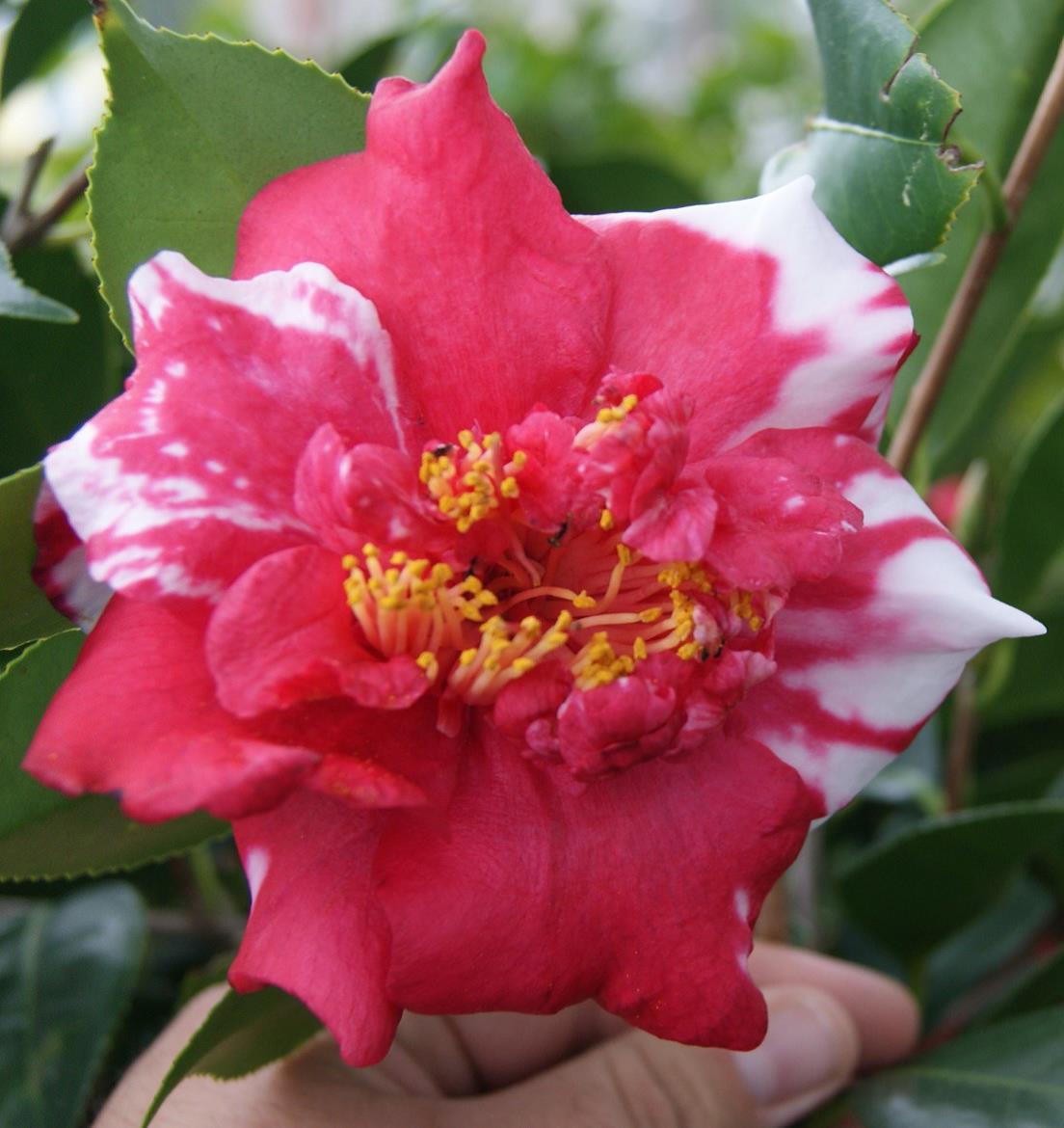
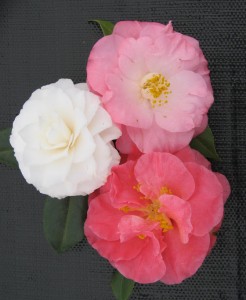
White by the Gate, Magnoliaeflora, and Spellbound camellia flowers
Are you looking for an evergreen shrub with showy flowers in the fall or winter? Look no further than an old Southern favorite, the camellia.
Large camellias dot landscapes of historic homes throughout the Florida Panhandle, and although they look like they’ve been here forever.
Camellias are not native to North America, but were originally brought here from Asia in 1797. There are many different types, but the most common camellias found in Florida are Camellia sasanqua which bloom in the fall (October – December) and Camellia japonica with larger leaves and a later bloom time of January through March. Some other types of camellias are Camellia reticulata, C. hiemalis, C. vernails and their hybrids; and Camellia sinensis is the source of tea which is made from the young leaves of this plant.
Flower colors range from a crisp white to a deep crimson and there are even some cultivars with variegated flowers! There are six recognized flower forms and they are single, semi-double, anemone, peony, formal double, and rose form double. Although most camellias have the potential to get over ten feet tall and five feet wide, there are some that grow slower and can be maintained at lower heights. Camellia sasanqua ‘Bonanza’ and C. sasanqua ‘Shishi Gashira’ have more horizontal branching habits and can be kept under five feet tall, however they will need more width than a more upright growing camellia.
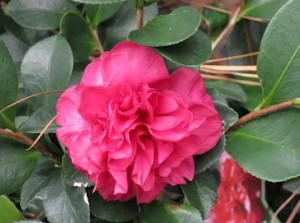
Camellia sasanqua ‘Bonanza’
When choosing a site for your camellia, look for an area with light shade, good air flow, and well-drained soil. Test your soil to determine pH and fertilizer needs before planting; soil testing kits can be picked up at your local county extension office. Camellias prefer acidic soil with a target pH range of 5.0 to 6.5, and benefit from organic matter amendments in sandy soil. Plant camellias slightly higher than the natural grade; dig a hole that is wide and shallow. After planting check that the top of the root ball is one to two inches above the soil line to allow for some settling. Mulching helps to conserve moisture and regulate soil temperatures, but be careful not to cover the root ball with thick mulch layers.
For more information about camellias and their care in Florida, please see Camellias at a Glance at http://edis.ifas.ufl.edu/pdffiles/EP/EP00200.pdf .

by Blake Thaxton | Oct 14, 2015

Photo Credit: UF/IFAS
It’s time to bed up some earth and plant strawberries! That right! Fall is the proper time to set out strawberry plants for a spring harvest. It is a common misconception that strawberries should be planted in the spring in the home garden. If planted in spring, such poor timing will result in a very reduced delicious strawberry harvest. Plant in the fall to ensure a tasty treat from your garden come spring time.
Strawberries do well on soil beds built to as tall as 10 inches and 20 inches wide. Two rows 12 inches apart can be planted on each bed. The plants should be spaced 12 inches within the row. Prepare your soil in you garden where it receives adequate sunlight, eight hours of direct sunlight is best. Two pounds to 10-5-10 can be mixed into the soil bed for every 10 foot of bed. It is even better to take a soil sample for analysis to know exactly what your garden needs to produce the best strawberry crop possible. Contact your local UF/IFAS extension office for more information on soil analysis.
Once a bed has been formed and you are ready to set plants it is important to have a plan for irrigation. The type of strawberry you plant will help you come up with the correct plan.
For freshly dug bare-root strawberry plants:
- Water with overhead irrigation frequently during the hottest parts of the day (10am-5pm) to ensure the plants to not wither and die. This will need to be done for one to two weeks until the plants are established.
For plug or containerized transplants:
- Very little overhead irrigation will be required as the root system is intact and functioning at the time of planting. Be sure to keep the soil moist for adequate establishment of this kind of strawberry plant.
For more information regarding growing strawberries in Florida visit solutionsforyoulife.ufl.edu or contact your local extension office.
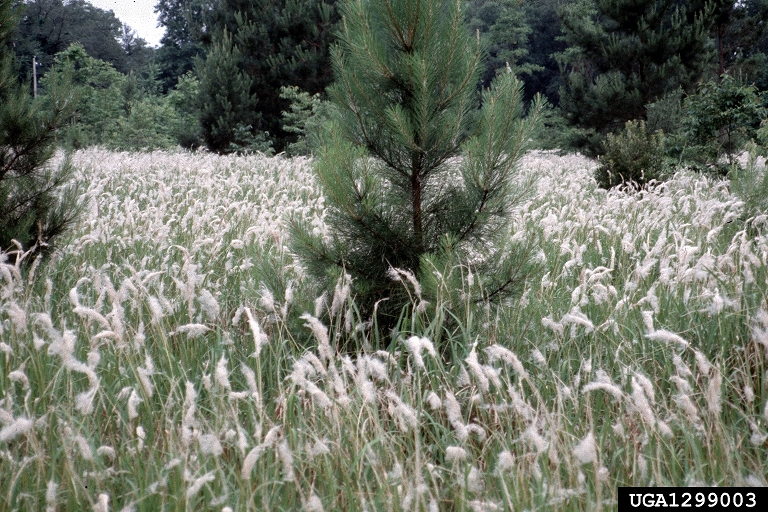
by Mary Salinas | Oct 14, 2015
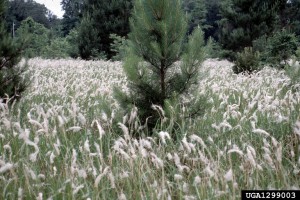
Cogongrass dominating the landscape. Photo credit: Charles T. Bryson, USDA Agricultural Research Service, Bugwood.org.
A U.S. Forest Service grant is again available to assist non-industrial private landowners with the cost of controlling cogongrass. Applications will be accepted starting October 15, 2015. The program reimburses landowners for 50% of the cost for two consecutive years with a maximum reimbursement of $10,000 for each year.
Cogongrass is one of the worst invasive plant species in Northwest Florida as it marches through natural areas and literally chokes out our desirable native vegetation as it goes. The underground rhizomes continually expand patches of the grass in every direction and its prolific seed production carries infestations to new areas.
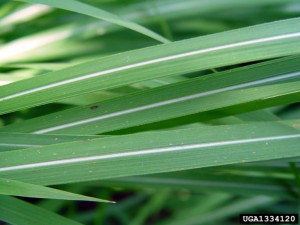
Note the off center midrib along the leaf blade. Photo credit: Chris Evans, Illinois Wildlife Action Plan, Bugwood.org.
There are several ways to accurately identify cogongrass. The leaf blades are flat with serrated edges and tend to be yellowish-green in color. The midrib which runs lengthwise up each leaf blade is white and is distinctly off-center. The seed head which arises in the spring is a fluffy white plume. Since it spreads through rhizomes, cogongrass is often seen in expanding circular patches.
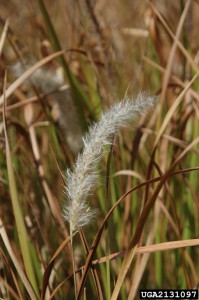
The fluffy white plume of the seedhead. Photo credit: Chris Evans, Illinois Wildlife Action Plan, Bugwood.org.
If you need assistance with the identification of cogongrass, please consult your local Extension office.
For more information:
Cogongrass Treatment Cost-Share Program
Cogongrass (Imperata cylindrica) Biology, Ecology, and Management in Florida Grazing Lands
by Larry Williams | Oct 6, 2015
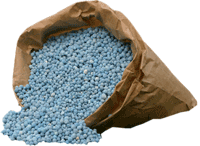
Fertilizer: Image Credit UF / IFAS
In Northwest Florida, all of our lawn grasses begin to fade and slowdown in growth during fall.They are supposed to go dormant. Some will go dormant earlier than others based on species, location and management.
The grasses we use to create lawns are warm season grasses such as centipedegrass, St. augustinegrass, bahiagrass, bermudagrass and zoysiagrass.
The cooler temperatures (particularly cooler night temperatures) and the shorter days of autumn trigger these grasses to slow down. Their color begins to fade and eventually they turn brown, usually after a frost or freeze.
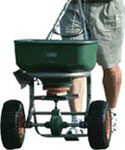
Fertilizer Spreader: Image Credit UF / IFAS
As these warm season grasses go dormant, they don’t need to be fertilized, particularly with a high nitrogen fertilizer. Some of the so called “winterizer” fertilizers available in our area can cause more damage than good despite the advertisements.
Nitrogen encourages new growth and interferes with the dormancy process, forcing the lawn to produce new tender growth at the wrong time of year. This sets the lawn up for damage. That young tender growth is very susceptible to cold injury and is likely to be damaged by the first frost. This greatly weakens the lawn and many times the damage goes unnoticed until the following spring when sections of the lawn do not green up. If you insist on “winterizing” your lawn, use a fertilizer with low nitrogen (represented by the first number in the fertilizer analysis) and high potassium (represented by the last number in the analysis). In most cases the center number (phosphorus) should also be low. But never use a high nitrogen fertilizer late in the season.
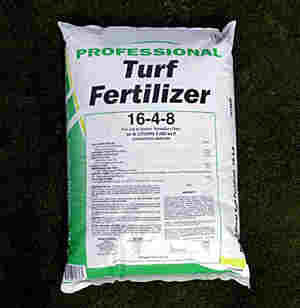
Fertilizer: Image Credit UF / IFAS
Large patch disease is another reason to avoid fertilizing after September, particularly with a high nitrogen fertilizer. Too much nitrogen at the wrong time promotes a common lawn disease called large patch, formerly known as brown patch. This disease is caused by the fungus Rhizoctonia. Large patch functions as a pathogen in our lawns during the cooler weather of fall and spring. Applying a high nitrogen fertilizer when large patch is active can be like applying gasoline to a fire, allowing this lawn disease to rage out of control.
In order for the fertilizer to do any good at all for the lawn, it needs to be applied while the grass is actively growing, when the grass can readily take it in. After the lawn is dormant and when the soil temperature is cooler, much of the fertilizer that could have benefited the grass is wasted.

 As the trees begin to turn various shades of red, many people begin to inquire about the Popcorn trees. While their autumn coloration is one of the reasons they were introduced to the Florida environment, it took years for us to realize what a menace Popcorn trees become. Sapium sebiferum, the Chinese tallowtree or Popcorn tree, was introduced to Charleston, South Carolina in the late 1700s for oil production and use in making candles. Since then, it has spread to every coastal state from North Carolina to Texas, and inland to Arkansas. In Florida it occurs as far south as Tampa. It is most likely to spread to wildlands adjacent to or downstream from areas landscaped with Sapium sebiferum, displacing other native plant species in those habitats. Therefore, Chinese tallowtree was listed as a noxious weed by the Florida Department of Agriculture and Consumer Services Noxious Weed List (5b-57.007 FAC) in 1998, which means that possession with the intent to sell, transport, or plant is illegal in the state of Florida.
As the trees begin to turn various shades of red, many people begin to inquire about the Popcorn trees. While their autumn coloration is one of the reasons they were introduced to the Florida environment, it took years for us to realize what a menace Popcorn trees become. Sapium sebiferum, the Chinese tallowtree or Popcorn tree, was introduced to Charleston, South Carolina in the late 1700s for oil production and use in making candles. Since then, it has spread to every coastal state from North Carolina to Texas, and inland to Arkansas. In Florida it occurs as far south as Tampa. It is most likely to spread to wildlands adjacent to or downstream from areas landscaped with Sapium sebiferum, displacing other native plant species in those habitats. Therefore, Chinese tallowtree was listed as a noxious weed by the Florida Department of Agriculture and Consumer Services Noxious Weed List (5b-57.007 FAC) in 1998, which means that possession with the intent to sell, transport, or plant is illegal in the state of Florida.













